Chapter 4 - Maintaining File Services
Introduction to Maintaining File Services
The chapter discusses the following tasks performed as part of network file volume maintenance:

Creating directories for users and applications. 
Setting drives to file volumes. 
Loading data and executable files into directories. 
Setting up the file system views for users to access in the SETARL, SETATTR, and V command programs. 
Using the VFILES program to manage file volumes. 
Monitoring server disk usage. 
Backing up network files.
Macintosh
The AFP service allows you to view and access VINES file services from Macintosh workstations. Through the Chooser desk accessory, you can set up folders for your users and load files onto the VINES file volume. In addition, you can use the VINES SETARL utility for the Macintosh to set up access rights. However, to monitor disk usage, back up file services, and perform other file service management tasks, you must use the server console or a DOS, Windows, or OS/2 workstation.
For information on the AFP service, see Chapter 7. For details on accessing VINES file services from a Macintosh workstation, see the VINES User's Guide for Macintosh.
This chapter explains how to use DOS and OS/2 commands and the VFILES program to maintain VINES file volumes.
Note: This chapter does not explain how to manage the file service called VINES Files, which contains the VINES programs. For information on managing VINES Files, see Chapter 6.
Using DOS and OS/2 Commands with File Volumes
To set up user access to local and network files, use the DOS and OS/2 commands, PATH, CD, and drive designators (such as E:) in the user profile.
All DOS and OS/2 commands that work from the system prompt also work on network file volumes, directories, and files. However, certain DOS and OS/2 utilities designed for local operation only, such as SUBST, CHECKDISK, JOIN, and FORMAT, do not work on network file volumes, directories, and files.
A DOS or OS/2 user's ability to execute a command or access an application depends on the user's access rights to the target file, directory, or volume, and on the attributes of the directory and files. For complete information on access rights and attributes, see Managing VINES Security.
Creating Directories on File Volumes
You can create directories from DOS, OS/2, and Windows workstations, or folders from Macintosh workstations that can access the VINES network. When creating directories or folders, use the procedures you would follow in the workstation's native file system. See Table 4-1 for the appropriate procedures.

From DOS, Windows, and OS/2 workstations only, you can also use the VFILES program to create directories and subdirectories. The VFILES program is described in "Using VFILES" later in this chapter.
Setting a Drive to a File Volume
Set a network drive to the file volume using the SETDRIVE command to access a newly created file volume from DOS, Windows, or OS/2 workstations. You can enter this command either:

At the command line using the syntax shown below 
Using the SETDRIVE menu, which is accessible from the command line and the VFILES program
The syntax for the SETDRIVE command is as follows:
SETDRIVE drive volume-name /R:pathname
where drive can be a letter from A to Z and volume-name is the name of the file service you created. If the file service name contains spaces, enclose the entire StreetTalk name in double quotation marks. A path in the directory is specified by pathname. If you omit the switch /R:, you access the root of the file volume.
It is recommended that you use only the letters E through Y as drive letters. The letters A through D should be reserved for workstation drives, and the letter Z designates the VINES file volume.
Macintosh
To access a VINES file service from a Macintosh workstation:
1. Log in to the VINES network through the Chooser accessory.
2. When prompted, select the file service from the listing. The VINES File volume icon appears on the desktop when the volume is successfully mounted.
3. Click the icon to open it.
For more complete instructions on accessing VINES from a Macintosh workstation, see the VINES User's Guide for Macintosh.
Loading Files into Directories
Use the same procedures to load files as you would to copy files on the native file system. Table 4-2 lists the appropriate procedures.

The source of a copy can be a local drive or another network file volume. The target is the desired network file volume.
Depending on the types of workstations on your VINES network and on your security needs, you may want to add an environment variable to the profiles of those users who will access the file system programs SETARL, SETATTR, and VDIR. By default, any user accessing the SETARL and SETATTR programs sees both the VINES view (for the DOS and OS/2 FAT file system) and the Macintosh view. By default, any user running the VDIR program sees the DOS short names and the Macintosh long names of directories and files.
To change these defaults, use the DOS SET command with the environment variable VIEWS in user profiles for consistent settings. For temporary settings (that is, per login session), issue the command at the system prompt. Use the following format for this command:
SET VIEWS=[file_system_view]
where [file_system_view] may be V (VINES), D (DOS), M (Macintosh), or U (UNIX). Table 4-3 shows which views you can access from each program by setting the environment variable.
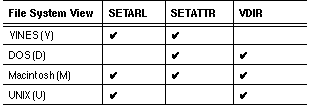
UNIX
The UNIX view is for VINES Toolkit users only and does not represent a UNIX client.
Example Using SET VIEWS
To limit the views for the SETARL, SETATTR, and VDIR programs, enter:
SET VIEWS=V D
This combination of VINES and DOS produces the following results:

VFILES is a program that allows you to access VINES File service programs and DOS file-management commands. From the VFILES main menu, which is called Managing VINES File Services, you can:

View all the information maintained by the file service about a directory, subdirectory, or file 
Troubleshoot an access problem quickly and easily 
Execute VFS commands
Figure 4-1 shows the VFILES main menu.
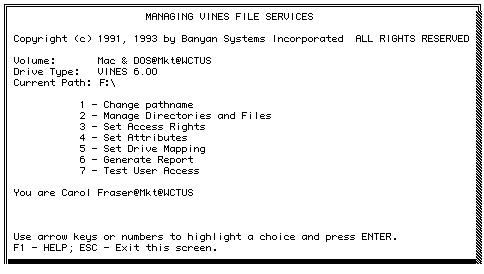
The VFILES main menu maintains a current path while you are using the program. You can change the current path as often as needed from within the program. When you exit the program, you return to the directory from which you entered the program.
Once you have set the path to a specific directory or file, you can use any of the tools shown in Table 4-5 to work on that directory or file. Table 4-5 also shows where to find detailed explanations of how to use these programs.
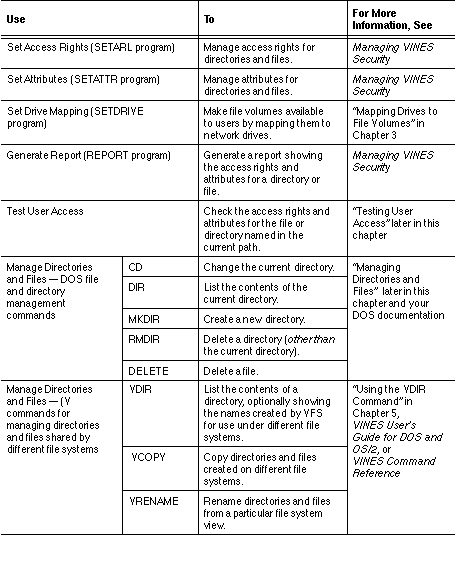
The V commands, SETARL, SETATTR, SETDRIVE, and REPORT are also directly accessible from the DOS command line. See the Command Reference for details on the command syntax.
You can access the VFILES main menu from the system command line or from the Control A Service menu.

In the SETARL and SETATTR programs, which are accessible from VFILES, you can change the current path. If you change the path while in one of these programs and do not change it back, the new path becomes the current path for VFILES when you return to the VFILES main menu. When you exit VFILES to the command line, you return to the directory that you were in when you entered the VFILES program.
If you choose the Set Drive Mapping, Set Access Rights, Set Attributes, and Generate Report options, use the programs as you usually would. For more information on the SETDRIVE program, see "Using the SETDRIVE Menu" in Chapter 3. For more information on the SETARL, SETATTR, and REPORT programs, see Managing VINES Security.
The sections that follow explain how to access the VFILES main menu and use the Change Path, Manage Directories and Files, and Test User Access options.
Accessing the VFILES Main Menu
Access the VFILES main menu from either:

DOS command line 
Control A Service menu
To Access VFILES from the Control A Service Menu
1. Access the Control A Service menu by running either MSERVICE or OPERATE. See "Accessing the Service Menus" in Chapter 2 for detailed instructions.
2. Choose MANAGE files. The VFILES main menu appears.
To Access VFILES from DOS Command Line
Table 4-7 lists the three different ways in which the VFILES command may be used from the DOS command line.
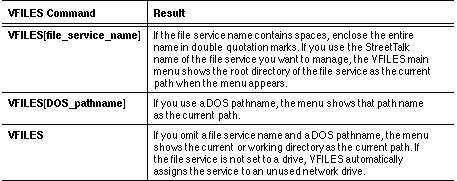
Automatic Drive Mapping
When you enter the VFILES main menu from MSERVICE or from the DOS command line, the VFILES program checks to see if the file service is set to a network drive. If it is not, the program selects an unused network drive and maps the file service automatically. The current path in the VFILES main menu reflects the mapping by showing the drive letter and the backslash for the root directory of the file service.
If VFILES automatically mapped a file service to a network drive, VFILES removes the mapping when you exit the program automatically. If all of your network drives are assigned, you receive an error message. You must use the VINES SETDRIVE command to change the mapping before you can enter the VFILES main menu.
The Change Pathname command appears in several file service menus. This command lets you choose another directory or file as the current path. You then use other commands in the menu to gather and modify information about the directory or file.
To Change the Pathname
1. From the VFILES main menu, choose Change Pathname. The system prompts you to enter the name of the new directory or file.
2. At the prompt, do one of the following:
- Enter the name of the directory or file and press ENTER. The VFILES main menu returns and displays the new path.
- Press F5 to display the Select Pathname screen. Use the right arrow key (Expand) to display subdirectories or files. Choose a directory or file. The VFILES main menu returns and displays the new path.
Managing Directories and Files
Choose Manage Directories and Files from the VFILES main menu to display the Manage Directories/Files menu. Figure 4-2 shows the Manage Directories/Files menu. From this menu, you can:

Change current pathname 
List all the entries in a directory 
Copy a directory or file 
Create a new directory 
Delete a directory or file 
Rename a file
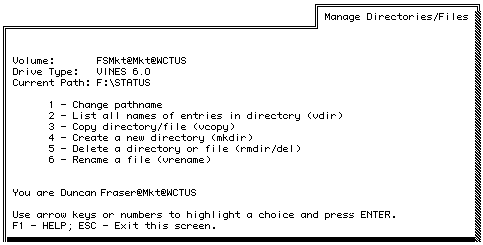
If you choose Change pathname from the Manage Directories/File menu, follow the procedure in "To Change the Pathname" earlier in this chapter.
The Create a new directory and Delete a directory or file options provide a screen interface for the DOS MKDIR, RMDIR, and DELETE commands. When you choose one of these options, a data entry screen appears, prompting you to enter the name of a directory or file. When deleting a directory or file, you can also press F5 to choose the Select Pathname screen.
The other options in the Manage Directories/Files menu provide access to the menu interface of the V commands, which are described in Chapter 5.
With the Test User Access option, you test a user's access to the directory or file shown in the Current Path field of the VFILES main menu. Use this test to troubleshoot user access problems.
This option provides both the ARL information and the attribute information for a directory or file. In addition, you see this information from all available file system views (depending on the SET VIEWS environment variable).
After you select the option, a screen is superimposed on top of the VFILES main menu so that you can still see the Volume (file service name), Drive Type, and Current Path fields of the VFILES main menu. You see the most recently saved view.
To Test User Access
1. From the VFILES main menu, choose Test User Access. The system prompts you to type in the StreetTalk name of a user.
2. Enter a user name to test and press ENTER. The system displays the access rights and attribute information for the current file system view.
3. Press F4 to view the information from other views.
Example Using Test User Access
Figure 4-3 shows a sample report that tells if the user is an administrator of the file service (that is, on the AdminList of the group in which the service was created).
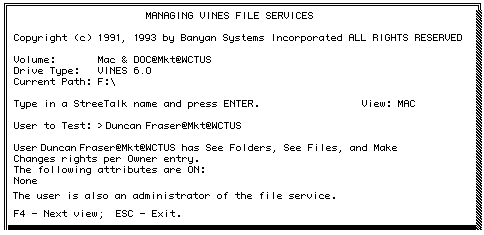
Monitor disk usage regularly. To conserve disk space, you and your users should delete files that are no longer needed. Create new file volumes on your disks as needed to minimize the overhead that accessing files on fewer file volumes can cause.
To monitor disk usage, you must work from a DOS, Windows, or OS/2 workstation.
1. From a PC on the network, either:
- Enter OPERATE servername, where servername is the name of the server containing the file volume whose disk space usage you want to monitor.
- Enter OPERATE. The Select A Server menu appears. Choose the server containing the file volume whose disk space usage you want to monitor.
The Operate A Server menu appears.
2. Choose SHOW server resources. The system displays the percentage of blocks in use for each disk.
If the VINES Network and Systems Management (VNSM) option is available, enter the MNET command at the system prompt to view what percentage of the disk is currently being used. Take appropriate action to keep it from filling up.
If the option is not available, run the Network Management program at the console of the server where a file service resides to obtain this information. See Monitoring and Optimizing Servers for more information.
Example Viewing Disks with VNSM
A server contains the following three disks that appear in the VNSM menus.
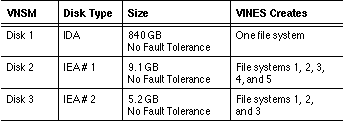
VINES software can create one or multiple file systems on a logical disk up to 16 GB in size. The user specified that VINES software create five file systems on IEA #1 and three file systems on IEA #2. When you create a file service on this server, instead of having a choice of disk1, disk2, or disk3, you have a choice of nine disks, one for each file system on IEAs #1 and 2 and one for the IDA disk. You also see the nine file systems when using the OPERATE program to monitor server resources.
Back up information stored on vulnerable media regularly. Users can back up their own files and directories with the appropriate methods at their workstations. Macintosh users can drag the appropriate file icons from their network folders to folders on their local drives. DOS, WINDOWS and OS/2 users can use the COPY command, with the network file volume as the source and the local drive as the target.
Note: Macintosh clients running System 7.1 or earlier cannot copy files to file services that are on large (greater than 2 GB) file systems. They can create and save files on these large file systems but cannot drag and drop files on them. This is a deficiency in the Macintosh OS that is fixed in System 7.5. See Technical Bulletin 362.
Back up files, directories, file volumes, or the entire contents of server disks with the VINES backup functions at the server console. You can also schedule regular backups to take place without operator intervention. See the Banyan Server Operations Guide for details.